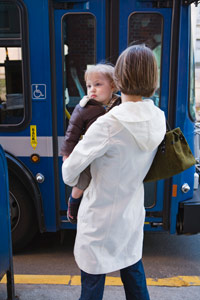
Barriers to care for HIV/AIDS
Women infected with HIV may have less access to or lower use of health care resources. This may be due to:
- Fewer financial resources
- Fewer health care resources available in the area
- Less access to transportation
- Added responsibility of caring for others, especially children
Many experts also believe poverty, unemployment, and lack of education are helping to "drive" the growing HIV problem among women. Women living in inner‑city poor neighborhoods are often in poor health and without access to health care for prevention or treatment. While risky behaviors in these communities directly spreads HIV/AIDS, urban poverty is also playing an important role.
Yet, the HIV problem does not only belong to poor neighborhoods in large cities, such as New York and Washington, DC. HIV also affects women in rural communities, particularly in southern states. Researchers in North Carolina found that African-American women with HIV infections were more likely to:
- Be unemployed
- Receive public assistance
- Have had 20 or more lifetime sexual partners
- Have a lifetime history of genital herpes infection
- Have used crack or cocaine
- Have traded sex for drugs, money, or shelter
In addition to these challenges, research has highlighted other issues that affect the lifespan of women with HIV. Studies have shown that women with HIV do not live as long as men with HIV, perhaps because women are less likely to be diagnosed early. Early diagnosis of HIV allows women to benefit more from antiretroviral drugs. Other issues may also play a role in this difference in survival.
- Women with HIV may have less access to or lower use of health care resources than men with HIV.
- HIV-positive women in abusive relationships may suffer violent reactions from partners.
- Women who are homeless have less access to care. Homeless women who are able to get treatment may not be able to stick with care routines because of irregular meals or not having proper places to store medicines.
- Some women with HIV may not have people around to provide emotional support or other types of help.
- Women may have more barriers to following their HIV medicine regimen. Women may be busy caring for other family members who are sick. They may fear telling their family about their HIV, or may have side effects that discourage them from taking HIV drugs.
More information on barriers to care for HIV/AIDS
Explore other publications and websites
-
The Affordable Care Act and People Living with HIV or AIDS — Nearly 30 percent of people living with HIV do not have any health insurance. This fact sheet talks about how the new health care law will make it easier for people living with HIV or AIDS to get the coverage and care they need.
http://www.healthcare.gov/news/blog/aca_aids_hiv.html
-
HIV/AIDS Among Youth — In the United States, HIV-related death has the greatest impact on young and middle‑aged adults, particularly racial and ethnic minorities. This fact sheet provides an overview of HIV/AIDS among adolescents, as well as risk factors and barriers to prevention.
http://www.cdc.gov/hiv/youth/
-
HIV/AIDS Programs: Find HIV/AIDS Care — This page has links to public health care programs for people living with HIV/AIDS.
http://hab.hrsa.gov/gethelp/index.html
-
National HIV and STD Testing Resources — This website has information and resources on HIV testing, including a national database of HIV testing sites. It also provides basic information about HIV/AIDS and behaviors that place a person at risk of infection.
http://www.hivtest.org/
-
Prevention Challenges — This fact sheet outlines the major biological and social factors that make women more vulnerable to becoming infected with HIV.
http://www.cdc.gov/hiv/topics/women/challenges.htm
-
State HIV/AIDS Hotlines — This Web page has phone numbers for state HIV/AIDS hotlines that can connect you to regional resources.
http://hab.hrsa.gov/gethelp/statehotlines.html
Connect with other organizations
-
AIDS.gov
http://www.aids.gov/
-
AIDSinfo
http://aidsinfo.nih.gov/
-
Divisions of HIV/AIDS Prevention, CDC, HHS
http://www.cdc.gov/hiv/dhap.htm
-
EngenderHealth
http://www.engenderhealth.org/
-
HIV/AIDS Programs, HRSA, HHS
http://hab.hrsa.gov/
-
UNAIDS
http://www.unaids.org/
Content last updated July 1, 2011.
Resources last updated July 1, 2011.
womenshealth.gov
A federal government website managed by the Office on Women's Health in the Office of the Assistant Secretary for Health at the U.S. Department of Health and Human Services.
200 Independence Avenue, S.W. • Washington, DC 20201


 Text size
Text size Email
Email
